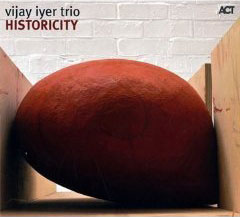A review of Vijay Iyer Trio’s “Historicity”
 Historicity is an exciting and unique record. The album takes jazz music forward and is destined to be one of the classic piano trio albums, and is firmly within the stream of jazz but innovative and freewheeling as all the best jazz is.
Historicity is an exciting and unique record. The album takes jazz music forward and is destined to be one of the classic piano trio albums, and is firmly within the stream of jazz but innovative and freewheeling as all the best jazz is.
Despite its unusual approach it’s a hugely accessible record: vital, rhythmic and engaging. Vijay Iyer refers to the trio’s music as spontaneous architecture. The trio have certainly taken and developed Iyer’s musical language and converse fluently in to create impressive soundscapes.
Iyer already has a body of recording behind him but seems to take flight with this record and he takes the listener with him. He also writes eloquently about his music. In a recent Guardian article, Iyer writes of his studies on Mathematics and Physics and how playing music from a young age made him a better Mathematician. Iyer has an agile mind, a desire to communicate, a Masters in Physics and a PhD in Technology and the Arts.
Many of the tunes begin with a fractured, kaleidoscopic or free time feeling and the pulse becomes gradually more explicit to the listener. That pulse is then danced around by Iyer’s dominant piano, Stephan Crump’s driving and expressive bass and Marcus Gilmore’s skittering, polyrhythmic drumming. Iyer is one of a kind.
There is a Karnatak (Southern Indian Classical) influence to some of the playing and composing. Iyer’s parents left India for the US before he was born. He is inspired by the rhythmic dimension on Indian, African and African American music. As Iyer writes ‘when you organise rhythms, you structure a listener’s experience in time.’ He connects the visceral impact of rhythm with natural body movements and speech patterns. Iyer was Influenced by his time with Steve Coleman and the M Base approach but also by the free approach of Hemphill, Roscoe Mitchell, Wadada Leo Smith, Butch Morris and others.
Stephan Crump, who has studied with Ray Drummond and Michael Moore, plays remarkable bass on this record. He makes great use of the bow and, because of the driving nature of Iyer’s piano, is often freed from the bass function to add his own imaginative sonic asides, counterpoints, slides and adventurous melodic and rhythmic ideas. Crump is sensitive, unconventional and provides great momentum to the music.
Originally from Memphis, Crump relocated to the New York jazz scene and is notable for the diversity of the acts he has played with. A brief list includes: Ashford and Simpson, Jorma Kaukonen, The Mahavishnu Project, Dave Liebman, Billy Hart, Sonny Fortune, Eddie Henderson, Ernie Watts, Greg Osby, Kenny Werner and Johnny Clyde Copeland. Phew! I guess not too surprising given his soulful playing, great tone and empathetic approach.
Historicity, the title track, opens with fractured piano phrases and soon draws the listener into the trio’s musical world. The bass and drums enter, Crump playing arco in high register as Iyer plays a bassline in his left hand. A more explicit groove gradually develops and the strong theme appears at 1:20. This is confident music. Crump has switched to fingers now and provides momentum under the dynamic piano solo as the Gilmore provides explosive bursts of snare and sizzling cymbals. The groove mutates and develops as the band interplay leads the song towards a restatement of the theme and the time is gradually and playfully manipulated as the tune reaches its dramatic conclusion and we are left gasping for more.
Somewhere is the Leonard Bernstein tune, but I didn’t recognize it in it’s reinvention. The bass walks in an obscured meter, the drums comment and the piano develops the theme. Gradually the listener becomes aware of a 5/4 pulse as the piano pounds out repeated descending lines. The dynamics subsume and Iyer plays a brilliant freewheeling solo over a 5/4 groove. The bass gets a melodic feature and Crump uses the full register and big upright tone as he takes flight over, and clearly enjoys interacting with Iyer and Gilmore’s accompaniment.
Galang is a rhythmic delight, a cover of the M.I.A. hip-hop tune it masterfully reinvents what was originally a song with electronic and sampled accompaniment into an exciting a visceral trio tune. Crump uses the bow to great effect throughout. M.I.A, who I know though the Slumdog Millionaire soundtrack, is a British rapper of Tamil origin.
Helix works well after Galang. A delicate ballad it appears to grow (rhythmically and melodically) quite organically. As the track develops it moves like grand crystalline structures of time to which the piano is ideally suited. The accelerations and decelerations are organic and conjure images of growth from nature like time lapse photography of seedlings.
Smoke Stack by the wonderful Andrew Hill is introduced by lovely rubato piano. As the band enter the tempo is freely interpreted, obscured and manipulated creating a fabulous headlong momentum as the implicit pulse becomes gradually more explicit. The trio interplay is beautiful as the track develops and the rhythm develops and eventually mutates into a wonderfully polyrhythmic drum solo. Gilmore plays like a one man African drum choir.
Big Brother, a Stevie Wonder cover from Talking Book is gospel and blues infused despite being a fairly abstract reading. A 7/4 piano solo over mournful arco develops the adapted blues form with a rich gospel feel. Stephan Crump plays some intense arco upright on this track in all registers.
Julius Hemphill’s Dogon starts with a righteous arco and drums groove. As the piano enters Crump plays beautiful elephantile arco over the 11/8 groove and then adds some funky double-stops as he interacts with the piano which has some dramatic, almost Buster Keaton, style moments. When Crump switches to pizzicato the effect is dramatic and the groove develops in fluidity. There are some delightfully funky interactions between bass and drums under the dramatic and thrilling piano solo. Crump then gets to develop his own flights of fancy during his brief bowed solo.
Mystic Brew‘s soul-jazz chords and funky groove serve as a release in another masterful piece of programming. Again, the trio’s approach is unconventional though. The Golden Mean demonstrates how rectangles get closer to perfect form when they develop the ratio 3;5, 5;8, 8:13, 13:21 etc The trio use this concept to develop the piece’s rhythmic figure (initially as 3 eight notes followed by 5 eighth notes into rhythmic superimpositions using the ratios 5:8 and 8:13. Sounds cerebral on paper but the effect in the music is passionate and dub-like. The effects are of cascading rhythms, expanding and contracting like growth slowed down. This is a CD with rhythm at its heart. I found this piece incredibly relaxing as I let its sound envelop me.
Trident begins with a more subdues mood. Ruminative and brooding in its introduction, the performance gradually builds and we are led through Iyer’s story as if by a master storyteller; Crump and Gilmore adding their own recollections and asides into the narrative. This is a passionate piece that at times led me to think of McCoy Tyner and flamenco though the piece is quite clearly Iyer’s own. References don’t spring to mind in Iyer’s playing (he sounds like Vijay Iyer) but, probably more reflective on me than him, I thought of Tyner, Geri Allen, Muhal Richard Abrams, Mal Waldron and Steve Coleman. The piece features Marcus Gilmore’s firework display like drumming as it heads towards it’s conclusion. It feels like the end of the record.
But it isn’t. Segment for Sentiment concludes the record. It begins with a quite exquisite bass introduction for a strong Iyer melody in which in bass and piano and take it in turns to lead and accompany each other like a 21st century Ellington/Blanton. The bass playing on this track is wonderful. It’s a rich ballad that seems to end the record on a question mark.
OK, that might read like an intense, fairly abstract performance. The record is quite accessible and engaging. As you might have guessed, I rather enjoyed it.
Historicity is a condition we all share – shaped by our past, we look to the future. This is a record shaped by African American jazz and the complex heritages and backgrounds of its performers that clearly sets out a forward looking vision of the music.
Historicity
Preview and download Historicity
Historicity Credits
Vijay Iyer: piano
Stephan Crump: bass
Marcus Gilmore: drums


EXCELLENT review by Phil Wain; nicely done! Makes me want to just get the disc RIGHT NOW, and at the same time gives me a great sense of what it's about. :)
Thanks so much for your kind comment Neil.
Is should confirm (thanks to Peter Hum for spotting this) that it is Marcus Gilmore on drums throughout and not Steve Gilmore (who is a bass player). There's usually at least one typo in my reviews! ; )
Thanks so much for your kind comment Neil.
Is should confirm (thanks to Peter Hum for spotting this) that it is Marcus Gilmore on drums throughout and not Steve Gilmore (who is a bass player). There's usually at least one typo in my reviews! ; )
[…] Vijay Iyer Trio – Historicity […]